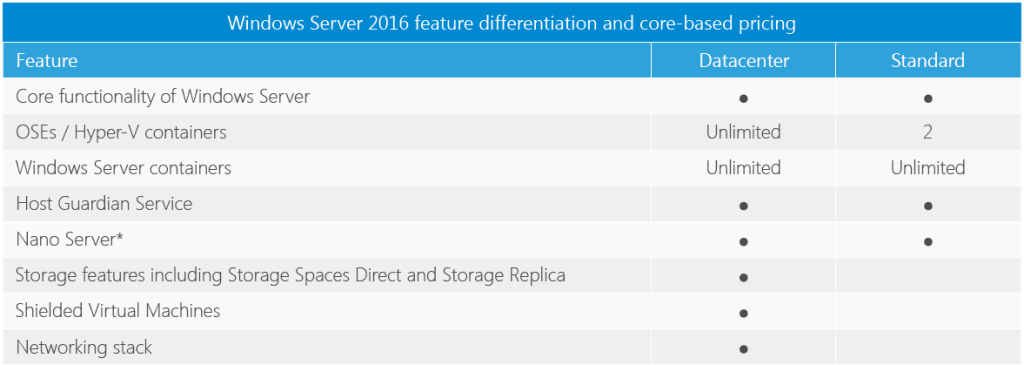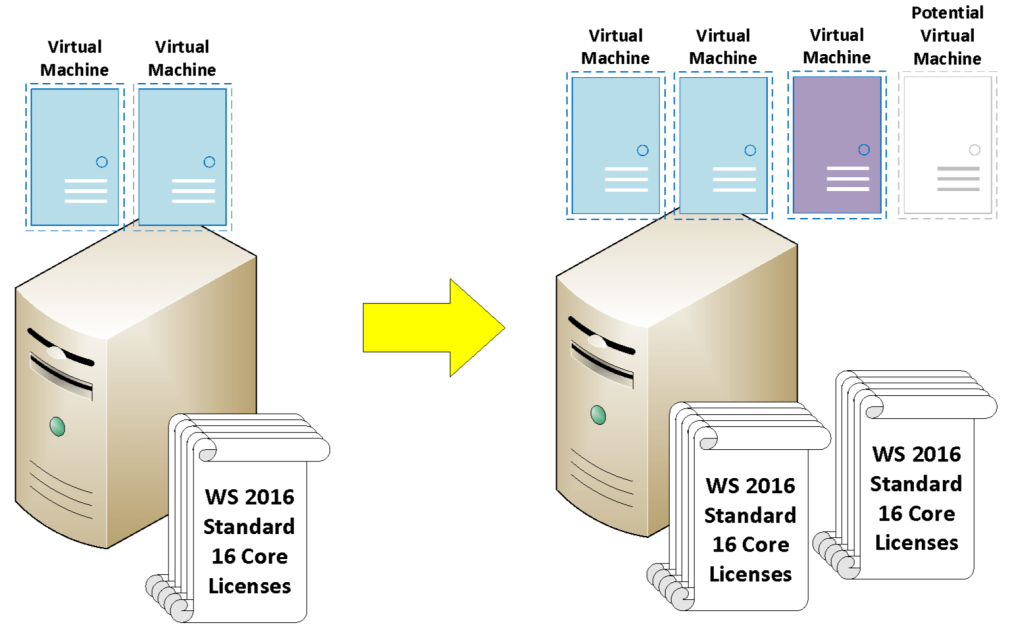
The Good News: Windows Server 2016 has been released!
The Bad News: Things just got a lot more complicated.
We’ve been receiving a number of questions recently about how to properly license an environment with Windows Server 2016. Core-based licensing, new minimum license counts, feature differences between the versions … People’s heads are spinning trying to figure it all out. But have no fear! Mirazon is here to help. Let’s start at the beginning and work our way through it.
Core-based Licensing
First, you need to wrap your head around core-based licensing. I devoted a whole blog post to this issue a while back. Core-based licensing can be boiled down to these three basic rules:
- License the physical server, not the VMs. With other Microsoft server products (such as Exchange or SQL) you can assign a license to either a physical host or a VM. But with Windows Server, the license is always assigned to the physical host.
- Cover every core. Every processor core inside your physical host needs to be covered by a core license.
- Meet the minimum. There is a minimum number of core licenses you must purchase to license a physical host for Windows Server. There is a 16-core minimum per server and an eight-core minimum per processor. If you have more than 16 cores in you host, you need to purchase additional licenses.
Datacenter Features
Second, you need to be aware that Datacenter once again includes advanced features. This was true in Windows Server 2008, but not in Windows Server 2012. One nice thing about Windows Server 2012 was that Standard and Datacenter had the exact same feature sets. The only advantage to getting Datacenter was that it gave you the right to spin up an unlimited number of VMs, whereas a Standard license only let you spin up two. Things were nice and simple.
Windows Server 2016 has the same distinction between Datacenter and Standard (unlimited VMs versus two VMs), but it adds a number of advanced features in Datacenter. Here is a feature comparison from Microsoft’s licensing datasheet (available for download here):
So the decision to go with either Datacenter or Standard is no longer based solely on how many virtual machines you’ll need. Now you also need ask yourself, “Do I need the advanced features?” If you need more information on these advanced features, check out Mirazon’s blog series on Windows Server 2016.
Stacking Standard Licenses for Additional VMs
Another tricky thing to understand in Windows Server 2016 is how to stack Standard licenses so you can run more than two VMs. Let’s say you go with Standard instead of Datacenter, but you need your host to run three VMs instead of two. How do you get licensed to run more VMs? Here’s the rule from the licensing datasheet:
“Standard Edition provides rights for up to two OSEs or Hyper-V containers when all physical cores in the server are licensed. For every two additional VMs, all the cores in the server have to be licensed again.”
So if you have 16 or more cores, then you must license all of those cores again in order to get permission to spin up two more VMs. If you need two more VMs in addition to that, then you must license all of those cores again. You just repeat the process until all your VMs are covered.
But what if you have less than 16 cores? You licensed your server with 16 core license to meet the minimum and to cover your first two VMs. But then what?
I checked the Product Terms document (the official rules when it comes to Microsoft licensing, available for download here). Here’s the answer: you need to meet the minimum again. In other words, you need to purchase licensing for an additional 16 cores if you need two more VMs. So here’s the rule of thumb: If you have less than 16 cores, you need to license your server as if you had 16 cores.
- Licensing a Windows Server for Three VMs
You’ll need to do something similar when you have a server with four processors. Remember that Microsoft requires you to buy at least 8 core licenses for each processor. So to license the server to run two virtual machines, you will need to buy at least 32 core licenses (8 x 4 = 32). To get permission to spin up an additional two VMs, you will need to buy 32 more licenses. So the principle is the same: you have to meet the minimum again to get permission to run two more VMs. But in a server with four processors, the minimum is now 32 cores instead of 16.
In the next post of this series, we will cover the pricing of Windows Server 2016 and discuss the price break between the Standard and Datacenter versions. Meanwhile, you can check out these related posts on the Mirazon blog:
- Windows Server Licensing Changes in 2016: Core-Based Licenses
- Windows Server 2012 Licensing Cost vs. Windows Server 2016 Licensing Cost
- Free Licensing for Windows Server 2016 Datacenter

